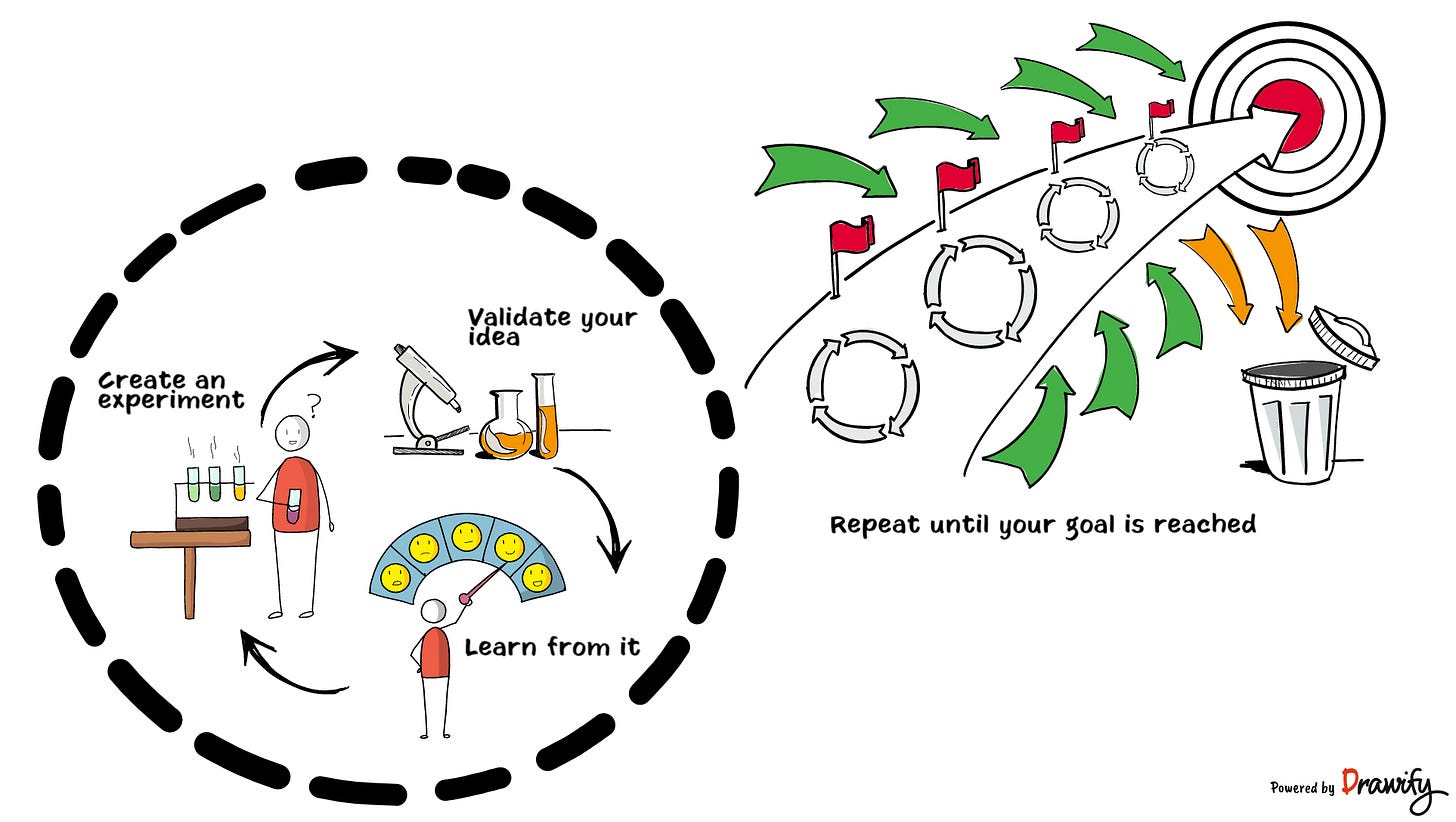7 steps to turn ideas into reality using test cards - use case example from a real working session
"Getting started is more important than being right"
Situation:
How many times have you reached a decision, made a prioritization of the work, or simply decided upon specific action points, and then you did not know if you were successful or not?
In the best case scenario when you did follow up on action points, what happens then when you want to know how to go on? How do you know how to iterate if you do not know what actually worked?
Why experimenting?
My biggest takeaway from experimenting in team workshops is that experiments take out the pressure of having something fixed. They do not have to be perfect from the start, we create them, validate them, and then iterate until we reach our goal.
“Getting started is more important than being right” says
, the CEO of Aj&Smart and author of newsletter.When you validate your ideas, you are engaging in critical thinking and using evidence to evaluate the validity of your ideas. This helps to activate the areas of your brain responsible for reasoning and decision-making.
If you want to understand why experimenting works with different personality types, stay tuned for tomorrow's post about it!
How did I use the Strategyzer Test Card in a teambuilding workshop? Use case below
In the Strategyzer book “Testing Business Ideas”, also available for free as a download on their website ( see Resources for the link), you can find the template of the Test Card.
Use Case: a tax accounting team asked me for a workshop on how to collaborate better and find the team working agreement they can apply
Steps I did in that workshop:
🎲 Sailboat - Positives: Started with the “What is moving us forward/ What’s working well in our team?” question. Asked them to write in silence as many sticky notes as they wanted with things that work well in the team. Then asked them to share those in turns.
🎲 Sailboat - Blockers: I asked them to write in silence on sticky notes answers to the question “What is holding us back from better collaboration in our team?” and encourage them to write as many as they come up to.
🎲 Deciding on what to focus on in that session: I gave them 3 red dots to each person and asked them to read all issues they wrote and vote in silence on the ones that they have the impression held them back from a good collaboration, bothers them the most, etc.
🎲 Rephrased the top-voted challenge into an HMW statement: we rephrased the top-voted sticky note into an HMW(How Might We) statement
🎲 Find solutions: I asked them to find solutions in silence for the top voted HMW statement = solving the biggest challenge they have - write as many solutions in 10 minutes, in silence
🎲 Decide: I asked them to eliminate duplicates, cluster the sticky notes and vote now again on the top solutions that they think will bring the biggest impact if followed and least effort.
🎲 Test cards: we took the top 3 solutions and split the team into 3 teams asking them to come up with as many ways of validating those solutions. We used test cards (you find them in resources) and each team could do as many as they wanted. I asked them each team to select 3 test cards that would be bringing the biggest impact to the team with the least effort. Important was to ask them to think as if they would create experiments, something that they can try out in the next weeks.
🎲 Commit to the next steps: I asked each team to present their test cards and then gave 3 voting dots to each person asking them to vote on the test cards that they think would be the best to try out in the next 4 weeks.
It was then clear what to do next, they had the cards on the walls in the next weeks as they were working in person and then we did a follow-up to check what worked, and what can be improved in the next iteration. After checking with them a few months later, they told me that the initial challenge they had was solved and that they went through other challenges already to solve them as well. Great team, a great achievement!
Facilitator hints:
Make sure you set expectations before the team works on test cards. It is an uncomfortable exercise, it is not easy to imagine how to measure their work and how they would be successful.
If you want to bring playfulness into this kind of work and help them think with their hands and make it even more tangible, use Lego Serious Play or Playmobil Pro and it will be not only deeper but also a fun way of creating a great outcome.
One-phrase summary:
If you want to make sure those action points decided at the end of a workshop will be put into practice and they are tangible ways to go forward to the specific team goal, then try Test Cards. They are experiments that bring people into the imagination exercise of what happens when they will apply what they decided and make the commitment higher usually.
The key is to follow up on these experiments and iterate on them.
Resources:
https://www.strategyzer.com/blog/posts/2015/3/5/validate-your-ideas-with-the-test-card
Strategyzer book: “Testing Business Ideas” by D.Bland, A.Osterwalder






Nice case. Thanks for sharing. I like that test card addition to the exercises .